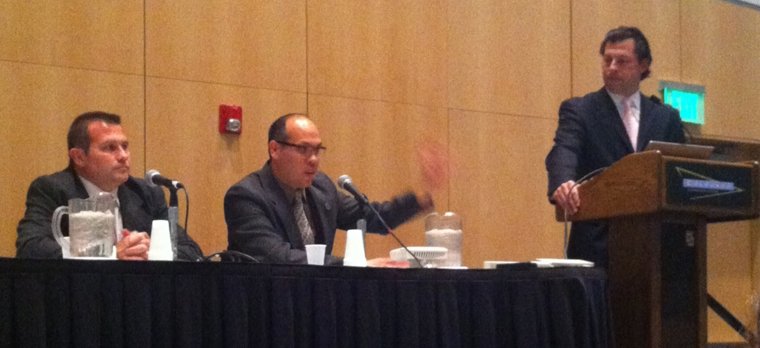EDUCAUSE 2012: How to Make Learning More Interactive and Impactful
When Peter Rettler, West Bend and online campus and community administrator for Moraine Park Technical College (MPTC), gives visitors a tour of the institution’s West Bend, Wis., campus, he shows them three things: the CNC lab, the nursing simulation center and the three classrooms equipped with telepresence technology. The reason, he says, is simple: “Everyone who has ever sat in [one of the telepresence room chairs] is wowed by it when the other site connects. We realized when we installed the technology that it was a tremendous marketing opportunity” for the college.
Rettler was one of two higher education leaders who shared his institution’s experiences with telepresence in a Wednesday afternoon session at EDUCAUSE. Moderated by Andy Lausch, CDW•G’s vice president for higher education, the session also highlighted findings from CDW•G’s Learn Now, Lecture Later report.
The spring 2012 survey of 1,015 K–12 and higher education students, faculty and IT staff found, for example, that a large percentage of institutions across the educational spectrum have used telepresence in their classrooms. Among higher education respondents, 43 percent of students and 27 percent of faculty use telepresence at least once a week, and 37 percent of students indicated that they wanted their professors to include even more telepresence activities in their teaching.
Such enthusiasm for the technology is prevalent both at MPTC and at Minnesota State University, Mankato (MNSU), which has satellite campuses situated more than 100 miles apart. Session co-presenter Edmund Clark, vice president for technology and CIO of the 16,000-student university in south-central Minnesota, told attendees that MNSU uses telepresence to connect with two-year colleges for baccalaureate completion to keep students in the state.
“Students are absolutely absorbed in the classroom experience” when telepresence is part of the equation, Clark said. “You can use telepresence as an aggregator for all sorts of technology.”
Rettler agreed, noting that the West Bend campus’s telepresence rooms are booked 65 percent of the time. “A typical classroom at our college is booked maybe 20 percent of the time,” he said.
When the deans request a room for meetings or class time, they always request a telepresence room, Rettler continued. “Once a faculty member teaches in one of these rooms, they don’t want to go back. Many deans would like to put their entire program in there right now.”
MPTC’s students also appreciate what telepresence can do: In a spring 2012 survey, more than 30 percent of students reported that they were more engaged in telepresence classrooms than they were in online classrooms. (About 25 percent of the students hadn’t yet taken a class in one of the telepresence classrooms.)
“Until you experience it for yourself,” Rettler added, “you don’t really know what it’s like.”
Clark agreed, noting that telepresence “changes the nature of the classroom” and creates a level of student engagement that can be difficult to capture otherwise. “The biggest win is having the faculty say, ‘I’m willing to teach in here,’” he said. “What used to happen is that people refused to use the video conferencing technology. But with telepresence, they’re willing to use it.”

Moraine Park Technical College’s Peter Rettler (from left), Minnesota State University, Mankato’s Edmund Clark and CDW•G’s Andy Lausch discussed telepresence best practices in a Wednesday afternoon session at EDUCAUSE.
Yes, but…
When implementing telepresence, Lausch advised, it’s important for colleges and universities to do four things:
- strengthen the infrastructure;
- factor annual maintenance costs into the overall investment picture;
- devise a strong project management plan covering all aspects of the implementation — not just IT; and
- be prepared to engage faculty throughout the transition.
“These are big investments,” Lausch pointed out, and figuring out the return on investment can be difficult.
Rettler acknowledged that building telepresence rooms involves significant commitments of both time and money. “Technology disappears with telepresence — you don’t see wires running all over the place — and that’s expensive to do,” he said. “HVAC noise levels also have to be reduced. The infrastructure costs can be quite expensive.”
At the same time, the long-term benefit to MPTC can’t be discounted. “We can’t really put a number on the marketing advantages [telepresence] gives us,” Rettler said. “I can tell you that the students find it more engaging, and the faculty prefer it.”
For more EDUCAUSE 2012 coverage, visit our EDUCAUSE 2012 page.








